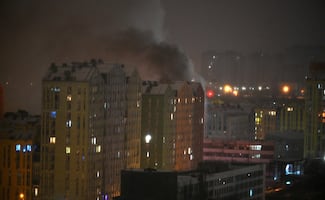Más Información

Lula conversa con Sheinbaum y extiende invitación para visita oficial a Brasil; ambos gobiernos condenan ataques a Venezuela

Juez da prórroga para cierre de investigaciones en caso del sujeto que acosó a Claudia Sheinbaum; audiencia será el 13 de enero

Tras descarrilamiento, Tren Interoceánico lanza nueva licitación para seguridad y vigilancia; firma convenio temporal para seguro de pasajeros

Cuerpo de Federico, niño de 2 años que falleció en accidente aéreo en Galveston, Texas, llega a Campeche; es velado en Escárcega
The U.S. president, Donald Trump, has just held office for three weeks and the Oval office has sparked off tension with world leaders from all continents, creating trade and diplomatic crisis at a global scale.
German magazine, Der Spiegel, has referred to Trump as “the world’s most dangerous man”, while Donald Tusk, president of the European Council, considers Trump “poses a threat similar to that of Russia or ISIS”. The confrontation list grows by the day: Mexico, the European Union, Germany, the Baltic states, Palestine, Australia, The People’s Republic of China, the seven mostly-Muslim nations facing the U.S. travel ban and which include Iran.
All of these are highly sensitive cases. However, the Asian case is exemplary in that it represents 60% of the world’s population (70% if one considers the Eurasian countries)and is the stage of the irresistible shift of the world’s economy from the north of the Atlantic to the Asian- Pacific basin.
The Obama administration designed “The pivot to East Asia” in 2012, a strategy which sought to strengthen safety allegiances, development fo trade and investment and the vitalization of the U.S. military presence. Four years later, the pivot has been deflated with the arrival of Donald Trump into the White House.
On the first day of his administration, the tenant of the Oval office issued a release where he informed that the U.S. abandoned the ratification process of the Trans-Pacific Partnership (TPP). Such agreement had been the cornerstone of the U.S. trade policy towards the Asian-Pacific basin.
Similarly, Trump noted that Tokyo and Seoul would have to pay for the umbrella of Western security that shields them against their self-conceived threat: Beijing. For his part, Trump has displayed erratic politics towards China, with the called held with the president of Taiwan, Tsai Ing-wen, he became a greater annoyance to Beijing. Trump allegedly amended on this last February 9th, by assuring the Chinese leader Xi Jinping that he will observe the One-China policy.
Examples of the clash between these two hegemonies increase by the day: the construction of artificial islands in the South China Sea, Beijings arms race, periods of manipulation of foreign exchange rates of the Yuan Renminbi, the U.S$347,000m trade deficit in 2016 and Hong Kong’s call urging for respect of the “One country, two systems” principle. Beijing claims have quickly surfaced: Washington transformed the Trans-Pacific Partnership (TPP) into a geopolitical instrument against China, the U.S. meddles with China’s domestic politics while keeping a steep military presence of the 7th Naval fleet in Asian waters, some 10,000 km from U.S. continental territory. Additionally Beijing insists that China is the only country with a real deterrent effect against Pyongyang’s potential use of nuclear weapons.
Trump has put the bipartisan politics Washington has followed for the last seventy years upside down. The great paradox lies precisely in that capitalism has triumphed at the same time the U.S. goes into a crisis over the solitude of its power, while its alleged greatest negotiator displays a greater ignorance for his lack of understanding of a win-win approach for both countries, as he only conceives victory through the annihilation of his adversary.
2017 marks the Chinese Year of the Rooster, the most intelligent of animals for the Chinese, while the U.S. becomes the shyster who instigates China, who aims at medium and long-term strategies as a response to the U.S. It was on January 17th, during the 2017 edition of the World Economic Forum in Davos, where Chinese leader, Xi Jinping picked up the baton as the great helmsman of globalization. Is a trade war between Washington and Beijing possible? Probably, but it would be a two-edged war that would harm both forces until they reach a draw.
Impacts from Asia to Mexico
Mexico is more important for China than we have come to realize. Our country is the watchtower from which Beijing analyzes the presence and influence of the Mexican and Mexican-American presence in the U.S., while studying the effects of the North American Free Trade Agreement (NAFTA), the first large scope trade agreement that brought together two highly industrialized nations with a developing country.
While Trump deters U.S. car-assembly plants from investing in Mexico, Giant Motors, who has Mexican tycoon Carlos Slim as a mayor stakeholder, invests in Mexican state of Hidalgo with the construction of a new Chinese car-assembly pant of JAC motors.
As a country, we have worn out our credibility with the revocation of the Mexico City- Querétaro fast train and for lack of a 15 or 20 year ahead planning, which is customary of the Chinese. The greatest threat for Mexico is the lack of an Asian strategy.
The limitations of consistently following the U.S. steps, instead of articulating a Mexican strategy based upon national interest and the intelligent involvement of our country in a crucial trade region for the 21st century, such as Asia, are made evident today, more than ever, in a 21st century that is regarded by some as the Asian century.
Carlos Heredia is an associate professor at CIDE
@Carlos_Tampico
Noticias según tus intereses
[Publicidad]
[Publicidad]










